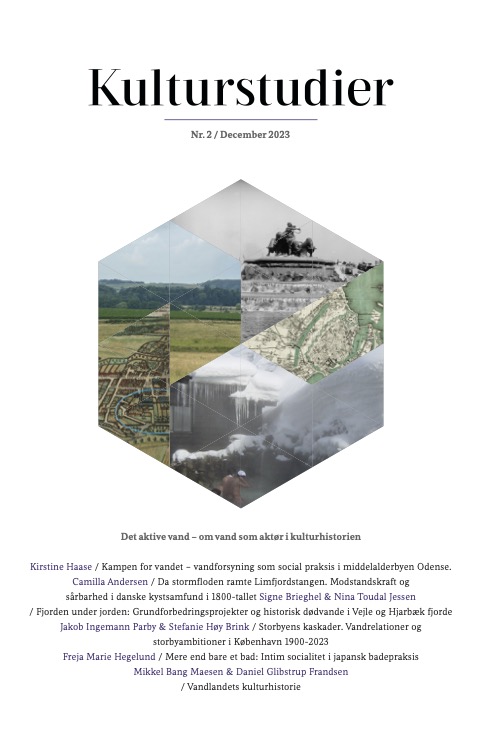Mere end bare et bad
– Intim socialitet i japansk badepraksis
DOI:
https://doi.org/10.7146/ks.v2023i2.142668Nøgleord:
Japan, vand, varme, badets kulturhistorie, den offentlige og private sfære, intim socialitet, kulturel sammenhængskraft, nationalidentitetResumé
Med afsæt i historiske og empiriske beskrivelser af offentlige og private badefaciliteter i Japan undersøger denne artikel kulturelle betydninger i japansk badepraksis. Ved at undersøge nøgenhed og varmt vand som mediatorer for nærhed og intim socialitet i Japan, udfordrer artiklen grænserne mellem den private og den offentlige sfære samt det intime og sociale. Artiklen viser, at badepraksis i Japan knytter bånd både på individplan og mellem statsborgere og argumenterer for, at badning i Japan er mere end bare et bad: Gennem intim socialitet genereres en imaginær varme og forbundethed mellem mennesker, som er et vigtigt element i den kulturelle sammenhængskraft og nationalidentitet i Japan.
Referencer
Anderson, Benedict 2001: Forestillede Fællesskaber: Refleksioner over nationalismens oprindelse og udbredelse. Roskilde Universitetsforlag, Frederiksberg.
Arendt, Hannah 1958: The human condition. University of Chicago Press, Chicago.
Bachnik, Jane M. 1994: “Introduction: Uchi/Soto: Challenging our Conceptualizations of Self, Social Order, and Language”. Jane M. Bachnik og Charles J. Quinn (red.): Situated Meaning: Inside and Outside in Japanese Self, Society, and Language. Princeton University Press, Princeton, New Jersey, s. 3-37. DOI: 10.1515/9780691194455.
Budds, Jessica 2008: “Whose scarcity? The hydrosocial cycle and the changing waterscape of La Ligua river basin, Chile”. Michael K. Goodman og Maxwell T. Boykoff (red.): Contentious Geographies: Environment, Meaning, Scale. Routledge, Abingdon, s. 59-68. DOI: 10.4324/9781315573953-13.
Budds, Jessica 2009: “Contested H(2)O: science, policy and politics in water resources management in Chile”. Geoforum 40, s. 418-430. DOI: 10.1016/j.geoforum.2008.12.008.
Butler, Lee 2005: “Washing off the Dust: Baths and Bathing in Late Medieval Japan”. Monumenta Nipponica (60)1, s. 1-41. DOI: 10.1353/mni.2005.0003.
Clark, Scott 1994: Japan, a view from the bath. University of Hawaii Press, Honolulu. DOI: 10.1515/9780824863067.
Damsholt, Tine 2008: ”I hamam: Når det akademiske køn går i opløsning”. Tine Damsholt; Dorthe Gert Simonsen og Camilla Mordhorst (red.): Materialiseringer: Nye perspektiver på materialitet og kulturanalyse. Aarhus Universitetsforlag, Århus, s. 89-116.
Daniels, Inge 2008: “Japanese Homes Inside Out”. Home cultures 5(2), s. 115-139. DOI: 10.2752/174063108x333155.
Daniels, Inge 2015: “Feeling at home in contemporary Japan: Space, atmosphere and intimacy”. Emotion, Space and Society 15, s. 47-55. DOI: 10.1016/j.emospa.2014.11.003.
Dawson, Andrew og Dennis, Simone 2020: “Social Intimacy”. Anthropology in Action 27(3), s. 1–8. DOI: 10.3167/aia.2020.270301.
Giddens, Anthony 1985: The Nation-State and Violence. Polity Press, Cambridge, England.
Gregory, Chris 2011: “Skinship”. HAU journal of ethnographic theory 1(1), s. 179-209. DOI: 10.14318/hau1.1.007.
Habermas, Jürgen 1989: The Structural Transformation of the Public Sphere: An Inquiry into a Category of Bourgeois Society. Polity Press, Cambridge, England.
Hanada, Tatsuro 2006: “The Japanese ‘Public Sphere’: the Kugai”. Theory, Culture & Society 23(2–3), s. 612-614. DOI: 10.1177/0263276406023002108.
Hastrup, Kirsten og Hastrup, Frida 2016: Waterworlds: Anthropology in fluid environments. Berghahn Books, New York. DOI: 10.1515/9781782389477.
Hastrup, Kirsten og Rubow, Rubow 2014: Living with Environmental Change, Waterworld. Routledge, London. DOI: 10.4324/9781315797465.
Herzfeld, Michael 2005. Cultural Intimacy: Social Poetics in the Nation-State. Routledge, New York. DOI: 10.4324/9780203826195.
Hotaka, Tsukada 2012: “Cultural Nationalism in Japanese Neo-New Religions: A Comparative Study of Mahikari and Kōfuku no Kagaku”. Monumenta Nipponica, 67(1), s. 133–157. DOI: 41686621.
Hylland-Eriksen, Thomas 2005: “Risking Security: Paradoxes of Social Cohesion”. Inaugural lecture Vrije Universiteit Amsterdam, 15/3 2005.
Ikegami, Eiko 2000: “A Sociological Theory of Publics: Identity and Culture as Emergent Properties in Networks”. Social Networks (67)4, s. 989-1024. DOI: 40971423.
Ikegami, Eiko 2005: Bonds of Civility: Aesthetic Networks and the Political Origins of Japanese Culture. Cambridge University Press, Cambridge. DOI: 10.1353/jsh.2006.0098.
Merry, Adam M. 2013: More Than a Bath: An Examination of Japanese Bathing Culture. CMC Senior Theses. Paper 665. Link: http://scholarship.claremont.edu/cmc_theses/665.
Moerman, Max 2015: “The Buddha and the Bathwater Defilement and Enlightenment in the Onsenji engi”. Japanese Journal of Religious Studies (42)1, s. 71–87. DOI: 43551911.
Nootbaar, Julie Joy 2023: “No Tattoos in the Bath: An exploration into the histories of tattooing and bathing in Japanese culture and why the two don’t mix in contemporary Japan”. Bulletin of Oita prefectural College of Arts and Culture 60, s. 47-56.
Plummer, Ken 2003: Intimate Citizenship: Private Decisions and Public Dialogues. McGill-Queen's University Press, Montréal. DOI: j.ctt130hj4x.8.
Rosenberger, Nancy R. 1994: “Indexing hierarchy through Japanese gender relations”. Jane M. Bachnik og Charles J. Quinn (red.): Situated Meaning: Inside and Outside in Japanese Self, Society, and Language. Princeton University Press, Princeton, New Jersey, s. 88-112. DOI: 10.1515/9780691194455.
Strang, Veronica 2015: Water: Nature and Culture. Reaction Books Ltd, London.
Swyngedouw, Erik 2004: Social Power and the Urbanization of Water: Flows of Power. University Press, Oxford. DOI: 10.1093/oso/9780198233916.001.0001.
Traphagan, John Willis 2004: “Culture and long-term care: the bath as social service in Japan”. Care management journals 5(1), s. 53-60. DOI: 10.1891/cmaj.5.1.53.61263.
Wang, Zi 2020: The Discursive Construction of Hierarchy in Japanese Society: An Ethnographic Study of Secondary School Clubs. De Gruyter Mouton, Berlin. DOI: 10.1515/9781501514876.
Welter, Albert og Newmark, Jeffrey 2017: Religion, Culture, and the Public Sphere in China and Japan. Springer Singapore, Singapore. DOI: 10.1007/978-981-10-2437-5.
Westrom, Michael 2018: “Bathing in Japan: Applying a practice theory vocabulary to energy use through ethnography”. Energy Research & Social Science 44, s. 232–241. DOI: 10.1016/j.erss.2018.05.018.
Wynn, Lesley 2014: “Self-reflection in the tub: Japanese bathing culture, identity, and cultural nationalism”. Asia Pacific Perspectives 12(2), s. 61–78.
Websteder
Japan for Sustainability 2013: Japan's Environment Ministry Campaign Encourages People to Save Energy through 'Warm Share', https://www.japanfs.org/en/news/archives/news_id032625.html (Besøgt 7/5 2023).
Japan Environment Quarterly 2013: Climate Change Policies in Japan / What are COOL BIZ and WARM BIZ?, https://www.env.go.jp/en/focus/jeq/issue/vol03/feature.html (Besøgt 7/5 2023).
Ministry of the Environment. Government of Japan 2016. Warmbiz, https://ondankataisaku.env.go.jp/coolchoice/warmbiz/info/20170214/index.html (Besøgt 7/5 2023).
Billedkreditering:
Illustration 1: MC MasterChef (https://commons.wikimedia.org/wiki/File:Modern_Ofuro.jpg), „Modern Ofuro“, https://creativecommons.org/licenses/by-sa/2.5/legalcode.
Illustration 2: Sanmai (https://commons.wikimedia.org/wiki/File:Modern_sento_at_Takayama.jpg), „Modern sento at Takayama“, https://creativecommons.org/licenses/by/2.0/legalcode.
Illustration 3: Markmark28 (https://commons.wikimedia.org/wiki/File:Tsurunoyu_onsen_rotenburo2.JPG), „Tsurunoyu onsen rotenburo2“, https://creativecommons.org/licenses/by-sa/3.0/legalcode.
Downloads
Publiceret
Citation/Eksport
Nummer
Sektion
Licens
Tidsskriftet forbeholder sig ret til førsteudgivelsen, mens ophavsretten til artiklen tilfalder forfatteren.
Artikler udgivet af Kulturstudier licenseret under en Creative Commons Navngivelse-IkkeKommerciel-IngenBearbejdelse 4.0 International Licens





